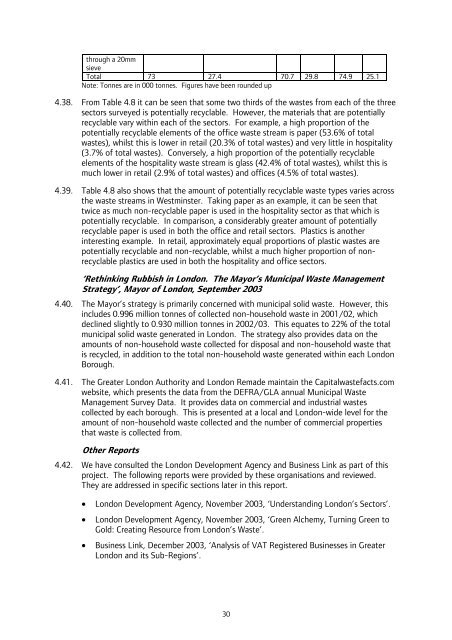London Wider Waste Strategy - London - Greater London Authority
London Wider Waste Strategy - London - Greater London Authority
London Wider Waste Strategy - London - Greater London Authority
You also want an ePaper? Increase the reach of your titles
YUMPU automatically turns print PDFs into web optimized ePapers that Google loves.
through a 20mm<br />
sieve<br />
Total 73 27.4 70.7 29.8 74.9 25.1<br />
Note: Tonnes are in 000 tonnes. Figures have been rounded up<br />
4.38. From Table 4.8 it can be seen that some two thirds of the wastes from each of the three<br />
sectors surveyed is potentially recyclable. However, the materials that are potentially<br />
recyclable vary within each of the sectors. For example, a high proportion of the<br />
potentially recyclable elements of the office waste stream is paper (53.6% of total<br />
wastes), whilst this is lower in retail (20.3% of total wastes) and very little in hospitality<br />
(3.7% of total wastes). Conversely, a high proportion of the potentially recyclable<br />
elements of the hospitality waste stream is glass (42.4% of total wastes), whilst this is<br />
much lower in retail (2.9% of total wastes) and offices (4.5% of total wastes).<br />
4.39. Table 4.8 also shows that the amount of potentially recyclable waste types varies across<br />
the waste streams in Westminster. Taking paper as an example, it can be seen that<br />
twice as much non-recyclable paper is used in the hospitality sector as that which is<br />
potentially recyclable. In comparison, a considerably greater amount of potentially<br />
recyclable paper is used in both the office and retail sectors. Plastics is another<br />
interesting example. In retail, approximately equal proportions of plastic wastes are<br />
potentially recyclable and non-recyclable, whilst a much higher proportion of nonrecyclable<br />
plastics are used in both the hospitality and office sectors.<br />
‘Rethinking Rubbish in <strong>London</strong>. The Mayor’s Municipal <strong>Waste</strong> Management<br />
<strong>Strategy</strong>’, Mayor of <strong>London</strong>, September 2003<br />
4.40. The Mayor’s strategy is primarily concerned with municipal solid waste. However, this<br />
includes 0.996 million tonnes of collected non-household waste in 2001/02, which<br />
declined slightly to 0.930 million tonnes in 2002/03. This equates to 22% of the total<br />
municipal solid waste generated in <strong>London</strong>. The strategy also provides data on the<br />
amounts of non-household waste collected for disposal and non-household waste that<br />
is recycled, in addition to the total non-household waste generated within each <strong>London</strong><br />
Borough.<br />
4.41. The <strong>Greater</strong> <strong>London</strong> <strong>Authority</strong> and <strong>London</strong> Remade maintain the Capitalwastefacts.com<br />
website, which presents the data from the DEFRA/GLA annual Municipal <strong>Waste</strong><br />
Management Survey Data. It provides data on commercial and industrial wastes<br />
collected by each borough. This is presented at a local and <strong>London</strong>-wide level for the<br />
amount of non-household waste collected and the number of commercial properties<br />
that waste is collected from.<br />
Other Reports<br />
4.42. We have consulted the <strong>London</strong> Development Agency and Business Link as part of this<br />
project. The following reports were provided by these organisations and reviewed.<br />
They are addressed in specific sections later in this report.<br />
• <strong>London</strong> Development Agency, November 2003, ‘Understanding <strong>London</strong>’s Sectors’.<br />
• <strong>London</strong> Development Agency, November 2003, ‘Green Alchemy, Turning Green to<br />
Gold: Creating Resource from <strong>London</strong>’s <strong>Waste</strong>’.<br />
• Business Link, December 2003, ‘Analysis of VAT Registered Businesses in <strong>Greater</strong><br />
<strong>London</strong> and its Sub-Regions’.<br />
30
















